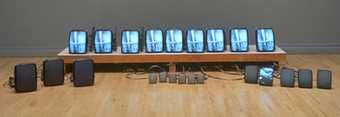Laser techniques to examine artworks
Tate Conservation is working with colleagues at the Foundation for Research and Technology Hellas, Institute of Electronic Structure and Laser (FORTH.IESL) in Crete and five other partners on a European Union-funded research project to develop the use of laser techniques for the examination of works of art.
The role of the two museum partners, the National Gallery Athens – Alexandos Soutzos Museum and Tate, will initially be to help define the requirements that will be needed to apply this technology to works of art and at a later stage to assess the resulting instrument. Two uses that we envisage are for the identification and characterisation of unique objects and for detecting changes in the condition of objects. Tate is particularly interested in the latter application since it would enable us to make further progress on our previous research into the deterioration of objects through handling, transport and environmental conditions.
Laser holography
The laser holography method being developed by FORTH and its partners will allow us to identify minute cracks, voids and discontinuities in works of art. The intention is to create an initial hologram of an object followed by a second hologram at a later date and then superimpose the two wave forms to observe the interference fringes resulting from any very small relative movement of parts of the object.
The left image shows a fringe pattern defining a structural ‘signature’ from a hidden defect. The next pictures show image processing routines using existing software to isolate key characteristics of the pattern. New software will be developed to provide further mathematical transformations.

Laser holography images showing a fringe pattern
Previous research into the deterioration of objects
In the past Tate’s Conservation department has made an important contribution to the assessment of the risks inherent in transport, loan and display of works of art. This culminated in a conference on the transport of works of art in 1991, which drew together specialists and directors from all the major museums in the world. The meeting clarified the risks and provided examples of good practice that remain the benchmark for current operating procedures in most museums.
However, not all issues were resolved. Theoretical analysis supported by practical studies at the Canadian Conservation Institute suggested that repeated low level vibration equivalent to the levels experienced in a lorry did not cause damage even after thousands of cycles. But this conclusion remains problematic because the researchers did not have a sophisticated method of identifying structural and mechanical failure on the microscopic scale, such as incipient cracking. It therefore remains important to attempt to identify on real works of art any low level damage that may be initially difficult to discern visually but may eventually accumulate as more obvious damage.
Growing need to effectively assess artworks
This question has become more important to address in the intervening period, especially at Tate, since there has been a significant increase in the transport of works of art and some important paintings are subjected to travel repeatedly. With the equipment built by the consortium we should be in a position to examine works of art in more detail and interpret the results in the light of our exhibition and loan experience. If the technique proves to be capable of identifying small changes such as invisible crack propagation, it may lead to significant new information that will inform Tate practice and allow us to make correct decisions on the handling and transport of works.
The multifunctional encoding concept is based on the holographic acquisition of structural features that are characteristic for each object. By repeating this process and comparing with the original hologram any deterioration or changes can be detected.

